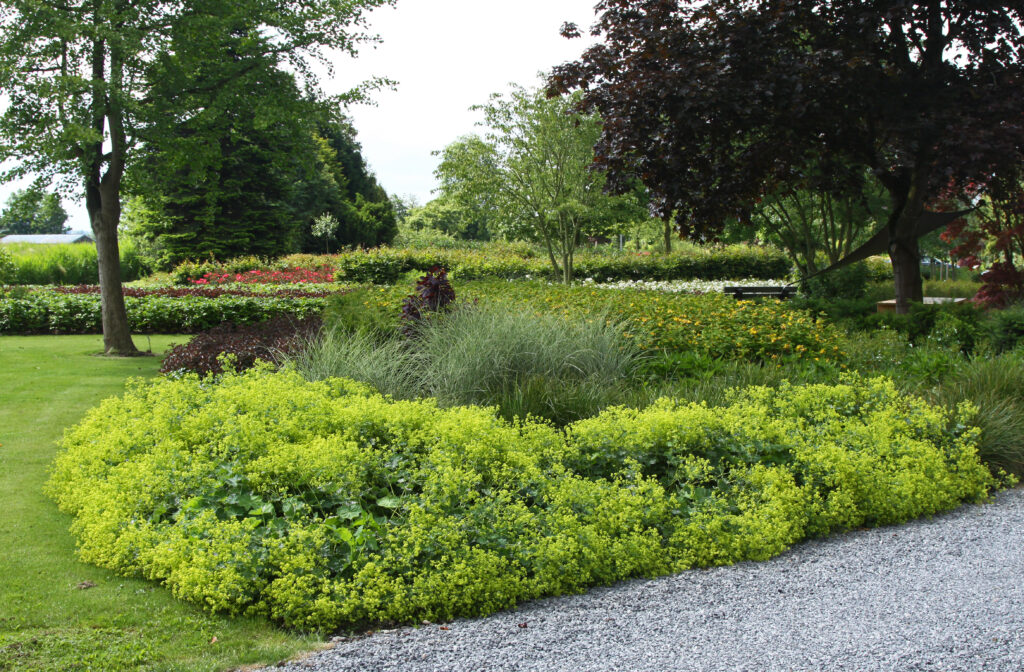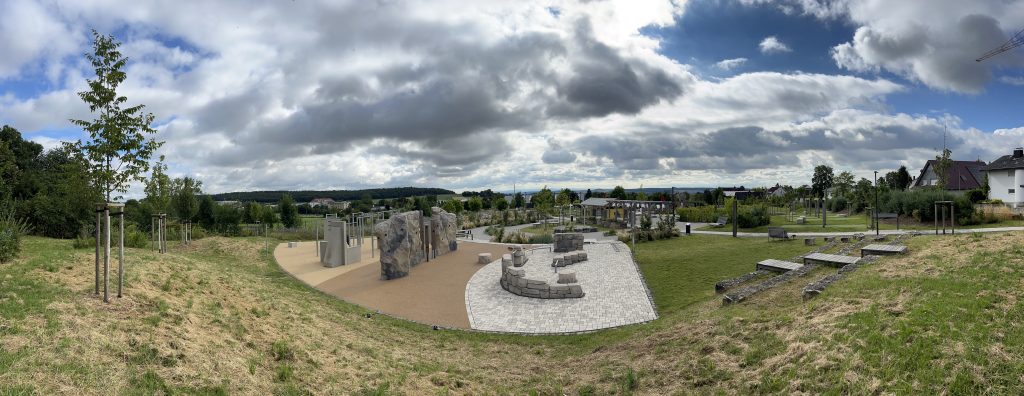The importance of trees and plants
the benefits of green
Trees and plants in the urban environment, help combat heat, drought, waterlogging and poor air quality and enhance biodiversity.
Combatting heat, drought and waterlogging. The power of trees is that they provide natural shade with their foliage, lowering the ambient temperature during hot summer periods and thus reducing the urban heat island effect. Trees and plants also absorb rainwater, decreasing the risk of waterlogging and reducing the chances of flood damage.
Enhancing biodiversity.Enhancing biodiversity. Trees and plants provide food and offer a habitat, protection and nesting opportunities for insects, birds and small mammals, thereby promoting biodiversity in urban areas .
Benefits in terms of health and social cohesion. Benefits in terms of health and social cohesion. Public greenery promotes physical activity, reduces stress, purifies the air, with a corresponding positive effect on people’s health. Moreover, green public spaces create meeting places, which strengthen social cohesion and contribute to a sense of well-being and connection within the community.
Green cities are attractive, resilient, and resistant to climate change, and provide a healthy, pleasant and sustainable living environment, for all of their residents , humans and animals alike.
Trees and plants from Boot Dart are used in a wide variety of green projects, including residential areas, public parks, business parks, roundabouts, roads and airports. Discover the versatile applications of our products in projects throughout Europe.
View our completed projects and be inspired. If you are working on a specific type of project and do not see it listed in the overview, please feel free to contact us: we are happy to share the knowledge and experience we have gained from similar projects. After all, we are the leading European specialists in landscape planting.
Climate-proof greenery
for a healthy city
Climate-proof green space is crucial in cities due to increasing extreme weather events such as heat waves and heavy rainfall. It strengthens cities’ resilience to climate change by reducing heat islands and preventing flooding. Greenery also contributes to better air quality and biodiversity, and helps restore natural ecosystems in urban areas. In short, climate-proof greenery is not only beautiful for residents, but also essential for sustainable, healthy and resilient cities.
Cool cooling plants
Box planters contribute to cooling the city. All urban greenery cools by evaporation, with the total volume of greenery rather than the plant species determining the effect. Large plant beds are therefore an important part of climate-proof urban green space. Well-sealed planting beds also keep the soil beneath them cool with their shade, reducing drying out and preventing excess heat from radiating out after sunset. Box plants with a fairly light colour or strong shiny leaves reflect the sun’s heat best.
Examples of well-closing bedding plants, which are suitable for large beds in the sun and have reflective foliage:
Names in green are native or contain native species
| Latin name | Local name |
| Aegopodium podagraria ‘Variegatum’ | Ground elder |
| Alchemilla mollis | Lady’s mantle |
| Aster ageratoides | Stokesia |
| Buddleja | Butterfly Bush |
| Carex (bontbladig) | Sedge |
| Cornus alba (geelbladig, bontbladig) | Dogwood |
| Cornus sericea ‘Kelseyi’ | Dogwood |
| Cotoneaster dammeri ‘Gelre’ | Cotoneaster |
| Deschampsia cespitosa | Tufted hairgrass |
| Deutzia gracilis | Deutzia |
| Euonymus fortunei (bontbladig) | Spindle tree |
| Geranium cantabrigiense, endressii, macrorrhizum | Cranesbill |
| Geranium ‘Rozanne’, ‘Tiny Monster’ | Cranesbill |
| Hedera hibernica | Ivy |
| Hippophae rhamnoides ‘Silver Star’ | Sea-buckthorn |
| Hydrangea | Hortensia |
| Hypericum dummeri ‘Peter Dummer’ | St. Johnswort |
| Juniperus pfitzeriana | Juniper |
| Kalimeris incisa | Japanese Aster |
| Lamium maculatum | Nettle, Spotted Dead |
| Ligustrum obtusifolium | Privet |
| Lonicera japonica | Honeysuckle |
| Lonicera nitida ‘Maigrin’ | Honeysuckle |
| Matteuccia struthiopteris | Shuttlecock fern |
| Microbiota decussata | Cypress, Russian |
| Nepeta | Catmint |
| Pachysandra terminalis ‘Green Sheen’ | Japanese Spurge |
| Pennisetum alopecuroides | Fountain grass |
| Photinia fraser ‘Red Robin’ | Red Tip Photinia, Christmas Berry |
| Physocarpus capitatus ‘Tilden Park’ | Ninebark |
| Physocarpus opulifolius ‘Dart’s Gold’ | Ninebark |
| Phlomis russeliana | Turkish sage, Jerusalem sage |
| Potentilla fruticosa | Cinquefoil, Bush |
| Ribes glandulosum | Flowering Currant |
| Rosa (vakbeplanters) | Rose |
| Rubus ‘Kenneth Ashburner’ | Blackberry |
| Salix repens | Pussy willow |
| Spiraea | Spirea |
| Stephanandra incisa | Stephanandra |
| Symphoricarpos chenaultii | Symphoricarpos |
| Symphytum azureum, grandiflorum | Comfrey |
| Taxus baccata ‘Summergold’ | Yew |
| Weigela (groen- en bontbladig) | Weigela |
Drought tolerance
Due to climate change, we face longer droughts in summer and higher temperatures. Especially in places with highly permeable soil and a low water table, this places higher demands on the drought tolerance of plants than before. Nevertheless, there are many species for professional planting that can cope with this just fine, while maintaining their quality in dry summers. It helps if drought is also taken into account with the layout of the planting area. Plants survive drought better if they have a sufficient volume of rootable soil. The type of soil should retain enough water, for instance because it also contains organic matter or clay. Plants can withstand drought better if they spend part of the day in (semi-)shade.
Examples of bedding plants that tolerate long periods of drought:
Names in green are native or contain native species
| Latin name | Local name |
| Agastache | Hyssop |
| Buddleja | Butterfly Bush |
| Buxus | Box, Common Box |
| Caryopteris | Bluebeard |
| Ceanothus | Californian lilac |
| Choisya | Mexican orange blossom |
| Colutea | Bladder-senna |
| Cotoneaster | Cotoneaster |
| Cytisus | Broom |
| Elaeagnus | Oleaster |
| Festuca glauca | Blue Fescue |
| Genista | Broom |
| Hypericum inodorum | St. Johnswort |
| Juniperus | Juniper |
| Lavandula | Lavender |
| Ligustrum lucidum | Privet |
| Melica ciliata | Silky-spike melic |
| Nepeta | Catmint |
| Origanum | Origanum |
| Pennisetum alopecuroides | Fountain grass |
| Perovskia | Russian sage |
| Philadelphus | Mock Orange |
| Phlomis | Jerusalem sage, Lampwick plant |
| Rosa rugosa en -hybriden | Rose |
| Sedum | Stonecrop |
| Stipa tenuissima | Oats |
| Symphoricarpos | Symphoricarpos |
| Verbena bonariensis | The purpletop vervain |
Infiltration section
An infiltration section is a planting area in public spaces that also serves as peak storage for downpours. The soil is usually flat; it is not a ditch, like a wadi. It also does not receive water from e.g. roofs. The soil in the compartment should be moderately to well permeable to water. The compartment should be laid at ground level with the paving, or the curb should be lowered locally, so that during heavy rainfall the water runs into the compartment and does not flood the street. Plants in an infiltration section should have sufficient drought tolerance to grow on fairly well-drained soil. If water runs into the compartment, it may well remain above ground for more than 2 hours, so the plants must also be tolerant of short-term waterlogging, which occurs only after peak rains. On highly permeable (sandy) soils, waterlogging usually lasts so short that even plants with only drought tolerance can survive in an infiltration patch.
Examples of species suitable for strip planting or as (block) hedges in infiltration areas. They tolerate both moderate drought and short-term flooding:
Names in green are native or contain native species
| Latin name | Local name |
| Acer campestre | Field maple |
| Aronia | Chokeberry |
| Aster divaricatus | Stokesia |
| Carex oshimensis | Sedge |
| Clethra alnifolia | Summersweet |
| Cornus alba | Dogwood |
| Cornus sanguinea | Dogwood |
| Cornus sericea | Dogwood |
| Crataegus monogyna | Thorn |
| Eupatorium cannabinum | Joe Pye Weed |
| Euonymus europaeus | Spindle tree |
| Hedera helix | Ivy |
| Hydrangea paniculata | Hortensia |
| Hydrangea quercifolia | Hortensia |
| Hydrangea serrata | Hortensia |
| Imperata cylindrica | Cogongrass |
| Itea virginica | Sweetspire, Virginia |
| Liriope muscari | Big blue lily-turf |
| Luzula sylvatica | Snowy woodrush |
| Miscanthus sinensis | Chinese silver grass |
| Physocarpus | Ninebark |
| Potentilla fruticosa | Cinquefoil, Bush |
| Rhododendron ‘Catawbiense Boursault’, ‘Roseum Elegans’ | Rhododendron |
| Ribes glandulosum | Flowering Currant |
| Rudbeckia fulgida | Black eyed Susan, Coneflower |
| Sarcococca hookeriana var. humilis | Sweetbox |
| Sorbaria sorbifolia | Spirea, Ash leaf |
| Spiraea betulifolia | Spirea |
| Stachys byzantina | Lamb’s ears |
| Viburnum burkwoodii | Viburnum |
| Viburnum opulus | Viburnum |
| Weigela | Weigela |
Wadi
A wadi is a lowering (ditch) in public spaces, which serves to temporarily collect rainwater and allow it to infiltrate. Water from paving or roofs is often directed towards a wadi. Grass usually grows in wadis, but there are several plant species that can also be used to create plant beds with higher ornamental value in a wadi. Wadi planting has advantages:
– The wadi gets all the benefits of a planting area, such as ornamental value, biodiversity value and effects on health, wellbeing and property value.
– Larger evaporating plants than grass make the wadi dry again faster
– Planting roots and the soil life they attract keep the soil well-drained
– Plants absorb (manure) substances from the water and clean the
– Beplanting is een vriendelijke manier om kinderen en honden uit mogelijk vervuild water te houden
Wadi plants should have tolerance to at least moderate drought; after all, they are in well-drained soil where it is dry when it is not raining. In addition, they should tolerate short-term waterlogging (several days). The same plants as mentioned for infiltration bays are suitable for shallow sections and embankments of wadis. In some cases, the wadi is deep, the soil has low permeability or water runs into it frequently and heavily. In that case, it is smart to use plants * on the wettest areas that can tolerate even long or frequent waterlogging, in addition to dryness.
Some examples:
Names in green are native or contain native species*
*Can be on the bottom of a wadi, the rest on the embankments
| Latin name | Local name |
| Acer campestre | Field maple |
| Aronia | Chokeberry |
| Aster divaricatus | The white wood aster |
| Carex oshimensis | Sedge |
| Cephalanthus occidentalis | Button Bush |
| Clethra alnifolia | Summersweet |
| Cornus alba | Dogwood |
| Cornus sanguinea | Dogwood |
| Cornus sericea | Dogwood |
| Crataegus monogyna | Thorn |
| Deschampsia cespitosa | Tufted hairgrass |
| Euonymus europaeus | Spindle tree |
| Eupatorium cannabinum | Joe Pye Weed |
| Frangula alnus | Alder Buckthorn |
| Hedera helix | Ivy |
| Hydrangea paniculata | Hortensia |
| Hydrangea quercifolia | Hortensia |
| Hydrangea serrata | Hortensia |
| Imperata cylindrica | Cogongrass |
| Iris pseudacorus* | Iris |
| Itea virginica | Sweetspire, Virginia |
| Liriope muscari | Big blue lily-turf |
| Luzula sylvatica | Snowy woodrush |
| Lythrum salicaria* | Purple Loosestrife |
| Miscanthus sinensis | Chinese silver grass |
| Molinia caerulea* | Purple moor-grass |
| Panicum virgatum* | Switchgrass |
| Physocarpus | Ninebark |
| Potentilla fruticosa | Cinquefoil, Bush |
| Rhododendron ‘Catawbiense Boursault’ | Rhododendron |
| Ribes glandulosum | Flowering Currant |
| Rudbeckia fulgida | Black eyed Susan, Coneflower |
| Salix repens* | Pussy willow |
| Sarcococca hookeriana var. humilis | Sweetbox |
| Sorbaria sorbifolia | Spiraea, Ash Leaf |
| Spiraea betulifolia | Spiraea |
| Stachys byzantina | Lamb’s ears |
| Viburnum burkwoodii | Viburnum |
| Viburnum opulus | Viburnum |
| Weigela | Weigela |


























